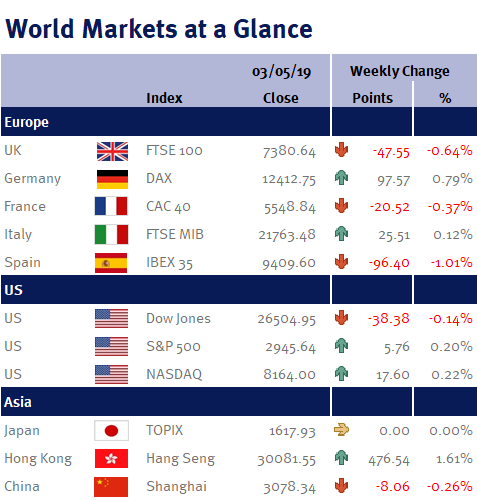It has been a busy week full of crucial data and economic events despite the fact a number of markets have been closed (Japanese markets were closed all week; Chinese markets were closed for three days and most European markets were closed on Wednesday 1 May 2019).
Week ending 3rd May 2019.
7th May 2019

China’s PMI data weakened slightly with the manufacturing PMI reading falling to 50.1 (from 50.5 in March). Although the reading remains just above 50, signalling expansion, we suspect the data may have been poor enough to actually be good news in that the Chinese central bank, the PBOC, may now provide further stimulus to the economy.
In the US, as expected, the Fed left interest rates unchanged during its meeting on Wednesday (1 May 2019) despite calls from Donald Trump to cut US interest rates by 1%.
However, it was the subsequent press conference hosted by the Fed Chairman, Jay Powell that was our main focus following the Fed’s recent U-turn and dovish shift on interest rates (the so-called “Powell Pause”).
The key question for us was whether the recent strong economic data will push policymakers back towards increasing interest rates, or whether the continuing weak inflation will push officials into endorsing an interest rate cut (on Monday 29 April 2019, the Fed’s preferred underlying inflation measure, the PCE, was flat on the month and at 1.6% – well below the central bank’s 2% target).
Disappointingly, in the end the Fed played it down the middle, saying that they didn’t “see a strong case for moving [interest rates] in either direction” as they believe that the factors currently depressing core inflation are “transitory”.
However, we have heard the Fed dismiss low inflation as transitory many times before!
We believe that there has been a generic shift down in inflation, hence our long held view that this will be one of the loosest tightening cycles ever (i.e. one that sees a very shallow path of interest rate increases with the high point for interest rates well below historic averages).
Much of the other data out of the US was mixed. For example, this week’s ISM reading showed a marked deceleration from 55.3 in March to 52.8 in April – the lowest reading since October 2016. And while the economy created 263,000 new jobs, the average hourly earnings was weaker than expected at 3.2%.
Meanwhile in the UK, the BoE also left interest rates unchanged following yesterday’s (Thursday 2 May 2019) monetary policy meeting. Although the BoE adopted a slightly more hawkish tone by saying that it would increase UK interest rates if there was a smooth Brexit, they have not convinced us that an interest rate increase is imminent, as in our opinion, any increase would be a policy error given household debt levels.
Looking ahead, we have another interesting week to look forward to, with UK Q1 GDP and industrial production; US CPI, PPI and trade data; Eurozone retail sales; and Chinese CPI and foreign reserves data.
Investment Management Team
The latest market updates are brought to you by Investment Managers & Analysts at Wealth at Work Limited which is a member of the Wealth at Work group of companies.
Links to websites external to those of Wealth at Work Limited (also referred to here as 'we', 'us', 'our' 'ours') will usually contain some content that is not written by us and over which we have no authority and which we do not endorse. Any hyperlinks or references to third party websites are provided for your convenience only. Therefore please be aware that we do not accept responsibility for the content of any third party site(s) except content that is specifically attributed to us or our employees and where we are the authors of such content. Further, we accept no responsibility for any malicious codes (or their consequences) of external sites. Nor do we endorse any organisation or publication to which we link and make no representations about them.

